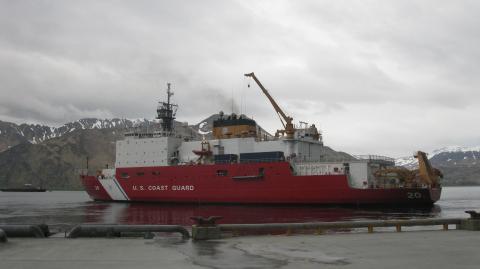Sea ice in the Arctic is retreating earlier each year, leaving more open water and changing the community of phytoplankton living in the water. Phytoplankton sit at the base of the food chain and are an important component of all marine ecosystems. In order to understand the changing communities of phytoplankton in the Arctic, Aimee Neeley, a graduate student at University of Maryland Center for Environmental Science (UMCES), spent a summer in the Chukchi Sea.

Neeley in the Arctic
Diatoms, which are at the larger end of the phytoplankton size scale, could be losing ground in the face of climate change. As ice retreats in the spring, diatoms bloom because they can grow quickly and take in many nutrients that are newly available as the ice melts. As those nutrients are consumed, smaller phytoplankton with a proportionately larger surface area start to take over, absorbing nutrients that diatoms cannot. “The community transitions from a beautiful diatom community to a diverse group of smaller phytoplankton when sea ice retreats and nutrients diminish,” explained Neeley.
Neeley, working with Lora Harris of UMCES and Karen Frey of Clark University, found that climate change conditions will favor smaller phytoplankton. Their results suggest that in the future Chukchi Sea will have smaller phytoplankton that are better at using different nutrients over a longer ice-free summer period. In addition, the spring diatom bloom will happen earlier and earlier, which could have huge impacts for the rest of the environment. “Benthic communities rely on the ritualistic timing of the phytoplankton spring bloom,” said Neeley, “and if that timing changes, everything else has to adjust to these new conditions.

USCGS Healy pulling away for ICESCAPE 2010. Credit: NASA
Their research was part of NASA project called Impacts of Climate change on the Eco-Systems and Chemistry of the Arctic Pacific Environment (ICESCAPE). The team traveled aboard the U.S. Coast Guard Cutter Healy in 2010 and 2011. A Mclane Labs Imaging Flow Cytobot, which is like a microscope and high-resolution camera combined, was used by Sam Laney from WHOI to collect phytoplankton taxonomic data. The tool took in water samples and produced images in real-time, cutting down on time analyzing the samples later.
While studying as a graduate student at UMCES, Neeley is also a contractor for NASA Goddard Space Flight Center, serving in the field support group of the Ocean Ecology Laboratory. They are responsible for processing satellite ocean color data, which can be used to derive information like carbon and chlorophyll concentrations in the water. Her job is to help collect water samples that can be used to support and validate their algorithms and understand satellite imagery. While her work at UMCES was for her dissertation, it directly feeds into her work at NASA. She hopes to use her knowledge and data on phytoplankton combined with satellite imagery to better understand how these marine communities are changing over time.

Some of the diatoms photographed by the team.
Data on phytoplankton community structure will need to be taken regularly in order to understand what is changing. “One issue when working in the Arctic is that there are not many publicly-available data sets that include phytoplankton taxonomy,” explained Neeley. “We need more phytoplankton taxonomy data from the past, present, and future.” Some of the challenges in collecting that data include limited travel ability and tedious microscopy work. Neeley hopes that in the future, more data will be collected with a tool like the one they used, and that scientists will have a more standardized approach to data collection. “Long term studies with these instruments are important to understanding ecology of the oceans and to help us understand any changes we are seeing,” she added.

Phytoplankton research has direct implications for the Chesapeake Bay. As temperatures and nutrients change in the Bay, phytoplankton communities are likely to change, which could have effects on all species living there. “Harmful algal blooms are happening more often,” said Neeley. “This is a prime example of changing community structure due to changes in inputs, like nutrients.” She added, “We need to tease apart what is happening in these ecosystems and better understand the transition.”
Their work was published in 2018 in Geophysical Research Letters.
